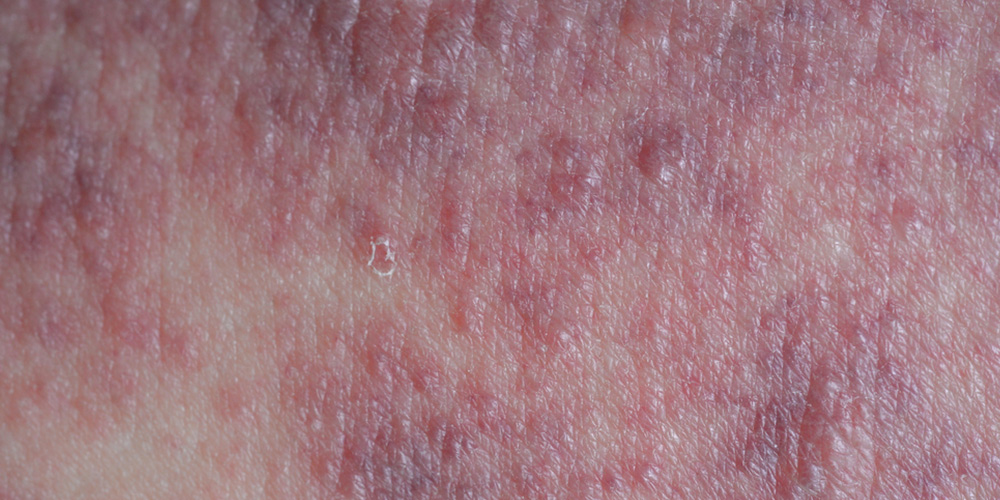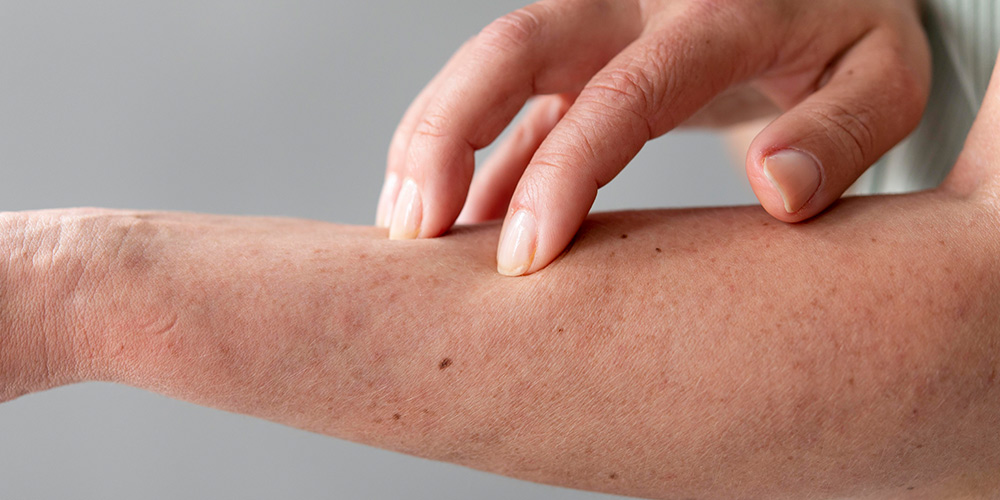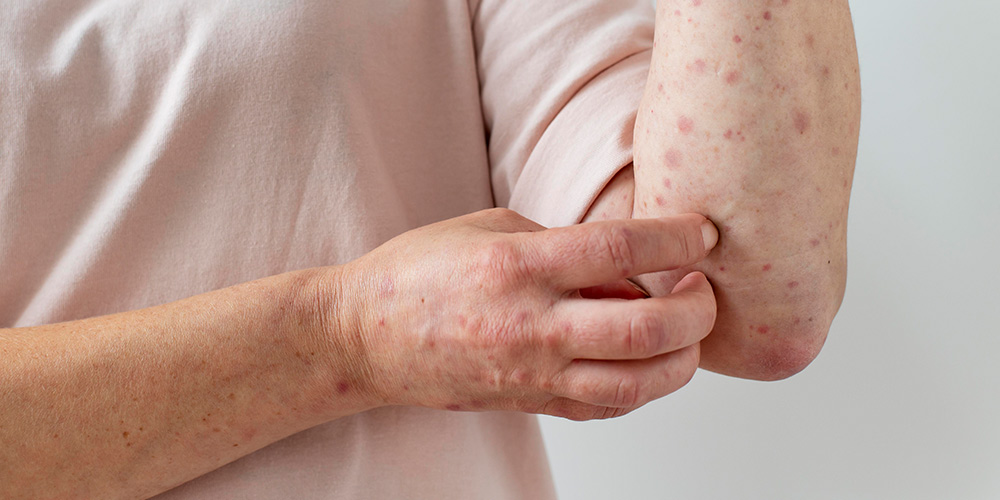Last Updated on January 25, 2024
Asteatotic Eczema or Xerotic Eczema occurs when the skin loses its natural oils, turning parched. In addition, it often targets the shins, arms, and legs, leaving its mark as red, scaly patches and deep, painful cracks.

Introduction
Eczema, a broad term encompassing various skin conditions, presents itself in diverse forms, affecting millions worldwide. However, one such variant is Asteatotic Eczema, a less commonly known but impactful skin issue. Therefore, in this comprehensive blog, we will delve into the intricacies of this Eczema type, exploring its symptoms, causes, and treatment options. Furthermore, from understanding the condition’s nature to discussing preventive measures, this guide aims to empower readers with knowledge for informed skincare.
What is Xerotic Eczema?
Asteatotic or Xerotic Eczema, also known as eczema craquele or winter itch, is characterized by dry, cracked, and fissured skin. However, “asteatotic” refers to the lack of sebum or natural oils on the skin’s surface, a prominent feature of this eczema subtype. Moreover, this condition often manifests in areas with less oil production, such as the lower legs, thighs, and arms.
Difference Between Eczema and Xerotic Eczema
While both eczema and xerotic eczema involve dry, itchy skin, they have some key differences
However, here’s a table summarizing them:
| Feature | Eczema | Xerotic Eczema |
|---|---|---|
| General | Umbrella term for inflammatory skin conditions | Specific type of eczema triggered by dry skin |
| Cause | Multifactorial (genetics, immune system, triggers) | Primarily lack of skin oils and moisture |
| Symptoms | Red, itchy patches, oozing/crusting, skin thickening | Severe dry skin, "crazy paving" pattern, less itch |
| Location | Any area of the body | Primarily lower legs, sometimes arms, thighs, trunk |
| Treatment | Topical/internal medications, phototherapy | Focus on restoring moisture, address underlying causes |
Symptoms of Asteatotic Eczema
Exhibits distinctive symptoms that set it apart from other forms of eczema:
Dry, Cracked Skin:
The hallmark of xerotic eczema is the presence of dry and cracked skin—additionally resembling the appearance of fine, intersecting lines.
Itching and Redness:
Intense itching, accompanied by redness, is common in affected areas, contributing to discomfort and irritation.
Fissures and Scaling:
Fissures or deep cracks in the skin, often accompanied by scaling, can be observed in severe cases of xerotic eczema.
Increased Vulnerability to Injury:
The compromised skin barrier makes individuals with xerotic eczema more susceptible to injury, infections, and inflammation.
Why Do People Get Asteatotic Eczema?
Understanding the underlying causes of eczema craquelé is crucial for effective management. However, several factors contribute to the development of this condition.
-
1. Decreased Sebum Production:
Reduced sebum production is a primary contributor to xerotic eczema. Additionally, this natural oil, produced by the sebaceous glands, is crucial in maintaining skin hydration and preventing excessive dryness.
-
2. Aging Skin:
As individuals age, their skin produces less sebum, increasing susceptibility to this eczema. Nevertheless, older adults are more prone to experiencing the drying effects of reduced sebum.
-
3. Low Humidity:
Environmental factors are significant, especially in regions with low humidity. Furthermore, dry air can strip the skin of its natural moisture, exacerbating the symptoms of asteatotic eczema.
-
4. Frequent Hot Showers:
Excessive exposure to hot water during showers can strip the skin’s natural oils. Additionally, it causes the skin to dry and increases the risk of xerotic eczema.
Common Risk Factors for Developing Xerotic Eczema
Certain factors increase an individual’s risk of developing asteatotic eczema, highlighting the importance of targeted prevention and management strategies.
-
1. Age:
Older adults are at a higher risk due to natural aging, which diminishes sebum production.
-
2. Climate and Weather Conditions:
Additionally, living in regions with low humidity levels, especially during winter, can elevate the risk of xerotic eczema.
-
3. Occupational Factors:
Certain occupations involving frequent exposure to drying agents or harsh chemicals can contribute to developing asteatotic eczema.
-
4. Underlying Health Conditions:
However, individuals with pre-existing conditions, such as thyroid disorders or diabetes, may be more susceptible to asteatotic eczema.
How is Asteatotic Eczema Treated?
Effectively managing asteatotic or xerotic eczema involves a multifaceted approach, including:
-
1. Emollients and Moisturizers:
Regular and liberal use of emollients and moisturizers is crucial to replenishing the skin’s moisture barrier. Additionally, creams containing ceramides and hyaluronic acid can be particularly beneficial.
-
2. Avoiding Hot Water:
Individuals with asteatotic eczema should opt for lukewarm rather than hot water during showers and baths. Moreover, using mild, fragrance-free soaps is advisable.
-
3. Humidifiers:
Introducing humidifiers in living spaces, especially during dry seasons, helps maintain optimal humidity levels, preventing excessive skin dryness.
-
4. Topical Steroids:
Healthcare professionals may recommend topical steroids to alleviate acute inflammation and itching symptoms. However, due to potential side effects, these should be used under medical guidance.
-
5. Prescription Medications:
However, for severe cases, oral medications, such as corticosteroids or immunosuppressants, may be prescribed to manage inflammation and control symptoms.
Can You Prevent Xerotic Eczema?
Prevention plays a pivotal role in managing xerotic eczema, especially for individuals at a higher risk. However, here are actionable steps to minimize the likelihood of developing this condition:
-
1. Regular Moisturization:
In addition to cold baths, consistent use of moisturizers with ingredients like ceramides and hyaluronic acid helps keep the skin hydrated.
-
2. Avoiding Harsh Soaps:
Opt for mild, fragrance-free soaps and cleansers to prevent stripping the skin of its natural oils.
-
3. Humidity Control:
However, in regions with low humidity, using humidifiers in indoor spaces helps maintain an optimal environment for the skin.
-
4. Gentle Cleansing Practices:
Adopting gentle cleansing practices and avoiding prolonged exposure to hot water during showers or baths can preserve the skin’s natural oils.
-
5. Protective Clothing:
Wearing breathable fabrics and protective clothing, especially in harsh weather conditions, protects against skin dryness.
-
6. Nutrient-rich diet:
A diet of essential fatty acids, vitamins, and minerals that support overall skin health. In addition, incorporating foods like fish, nuts, and leafy greens can contribute to skin hydration.
Who Does Asteotatic Eczema Affect?
Asteatotic eczema exhibits some distinct demographic patterns:
Age:
It most commonly affects older adults, with the median age of presentation at 69.
Gender:
Men older than 60 years develop asteatotic eczema more frequently than women. However, this discrepancy is partially attributed to hormonal changes in post-menopausal women.
Race and Ethnicity:
Although no specific racial or ethnic groups are disproportionately affected, some studies suggest a higher prevalence in individuals with light skin.
Other factors:
Underlying medical conditions: Additionally, individuals with hypothyroidism, malnutrition (zinc and fatty acid deficiencies), severe weight loss, and lymphoma are more susceptible.
Genetics: While the exact role of genetics remains unclear, a family history of dry skin or other atopic conditions may increase the risk.
Additionally, Asteatotic eczema is often a complication of inherited or acquired forms of ichthyosis, a group of skin disorders characterized by dry, scaly skin.
Conclusion
Asteatotic Eczema, although less known than some other forms of eczema, can significantly impact an individual’s quality of life. However, recognizing its symptoms, understanding the underlying causes, and implementing effective preventive and treatment measures are vital to managing this condition. Additionally, by adopting a holistic approach that combines skincare practices, lifestyle adjustments, and medical interventions when necessary, individuals can navigate the challenges of xerotic eczema with greater resilience and skin health. Nonetheless, informed choices and proactive care are crucial to cultivating skin well-being.



